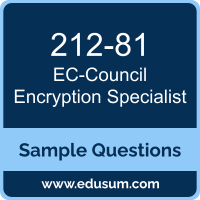01. What were the primary weaknesses of mono-alphabetic substitution ciphers?
(Choose two)
a) Predictable patterns in the letter substitution
b) High computational complexity
c) Vulnerable to frequency analysis
d) Requires multiple encryption keys
02. Which of the following are features of a block cipher?
(Choose two)
a) Operates on fixed-size blocks of data
b) Can be used in modes like ECB and CBC
c) Requires a key of arbitrary length
d) Encrypts one bit of data at a time
03. Which of the following is a primary use of Public Key Infrastructure (PKI) in cryptography?
a) To facilitate secure key exchange using symmetric encryption
b) To digitally sign data and ensure authenticity
c) To encrypt data during transmission over the internet
d) To compress data before transmission
04. Which of the following protocols uses SSL/TLS to secure communications between a client and a server?
a) HTTP
b) FTP
c) HTTPS
d) SMTP
05. You are tasked with advising a financial institution on the potential impact of quantum computing on their cryptographic systems. The institution currently relies heavily on RSA and ECC for securing sensitive data and transactions.
With the advancements in quantum computing, what changes should you recommend to ensure the continued security of their systems in the future?
a) Continue using RSA and ECC, as quantum computers are not likely to pose a threat for the next several decades.
b) Transition to using lattice-based cryptography and explore the adoption of quantum key distribution (QKD) for secure key exchange.
c) Encrypt all data with symmetric encryption and ensure that all keys are long enough to withstand brute-force attacks.
d) Move to post-quantum cryptographic algorithms that are quantum-resistant, but continue using RSA and ECC until they are fully broken.
06. What is the main difference between linear cryptanalysis and differential cryptanalysis?
a) Linear cryptanalysis uses plaintext-ciphertext pairs, while differential cryptanalysis uses ciphertext-only attacks
b) Linear cryptanalysis is more effective against asymmetric ciphers, while differential cryptanalysis works only on symmetric ciphers
c) Differential cryptanalysis looks for patterns in the difference between plaintext and ciphertext, while linear cryptanalysis looks for linear approximations
d) Differential cryptanalysis is easier to implement compared to linear cryptanalysis
07. Which of the following algorithms is based on the principles of number theory and is commonly used in asymmetric encryption?
a) RSA
b) AES
c) DES
d) Blowfish
08. Which of the following are known cryptanalytic techniques for breaking the AES encryption system?
(Choose two)
a) Linear cryptanalysis
b) cryptanalysis
c) Side-channel attacks
d) Brute-force attacks on the key
09. Which of the following methods is primarily used in the Diffie-Hellman key exchange algorithm to establish a shared secret between two parties?
a) Modular exponentiation
b) Matrix multiplication
c) Elliptic curve multiplication
d) Prime factorization
10. Which of the following quantum computing approaches are being explored for securing cryptographic systems against quantum attacks?
(Choose two)
a) Lattice-based cryptography
b) Post-quantum cryptography
c) Quantum key distribution
d) RSA encryption
 The purpose of this Sample Question Set is to provide you with information about the EC-Council Encryption Specialist exam. These sample questions will make you very familiar with both the type and the difficulty level of the questions on the 212-81 certification test. To get familiar with real exam environment, we suggest you try our Sample EC-Council Encryption Specialist Certification Practice Exam. This sample practice exam gives you the feeling of reality and is a clue to the questions asked in the actual EC-Council Certified Encryption Specialist (ECES) certification exam.
The purpose of this Sample Question Set is to provide you with information about the EC-Council Encryption Specialist exam. These sample questions will make you very familiar with both the type and the difficulty level of the questions on the 212-81 certification test. To get familiar with real exam environment, we suggest you try our Sample EC-Council Encryption Specialist Certification Practice Exam. This sample practice exam gives you the feeling of reality and is a clue to the questions asked in the actual EC-Council Certified Encryption Specialist (ECES) certification exam.